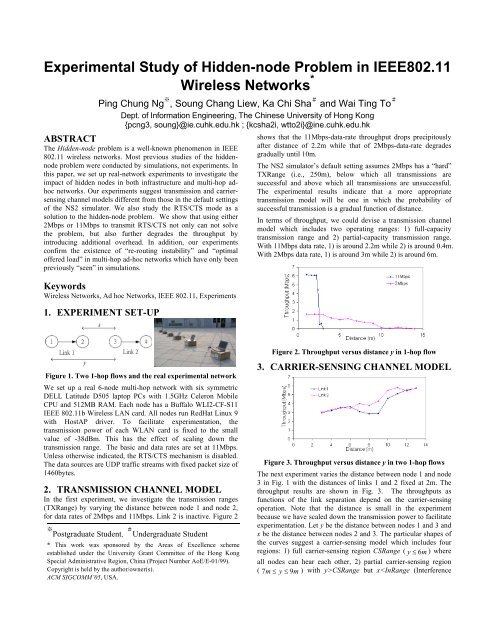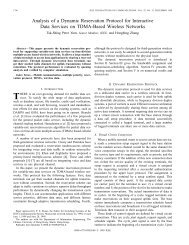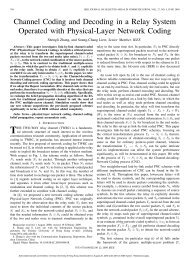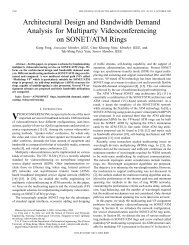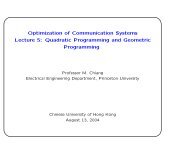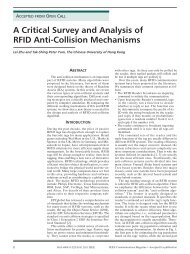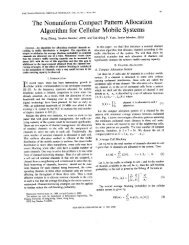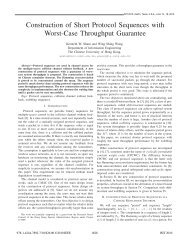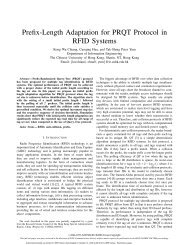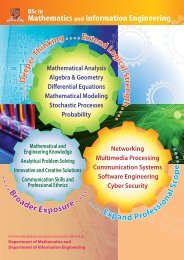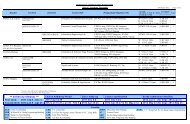Experimental Study of Hidden-node Problem in ... - CiteSeerX
Experimental Study of Hidden-node Problem in ... - CiteSeerX
Experimental Study of Hidden-node Problem in ... - CiteSeerX
Create successful ePaper yourself
Turn your PDF publications into a flip-book with our unique Google optimized e-Paper software.
<strong>Experimental</strong> <strong>Study</strong> <strong>of</strong> <strong>Hidden</strong>-<strong>node</strong> <strong>Problem</strong> <strong>in</strong> IEEE802.11<br />
Wireless Networks *<br />
P<strong>in</strong>g Chung Ng ※ , Soung Chang Liew, Ka Chi Sha # and Wai T<strong>in</strong>g To #<br />
Dept. <strong>of</strong> Information Eng<strong>in</strong>eer<strong>in</strong>g, The Ch<strong>in</strong>ese University <strong>of</strong> Hong Kong<br />
{pcng3, soung}@ie.cuhk.edu.hk ; {kcsha2i, wtto2i}@<strong>in</strong>e.cuhk.edu.hk<br />
ABSTRACT<br />
The <strong>Hidden</strong>-<strong>node</strong> problem is a well-known phenomenon <strong>in</strong> IEEE<br />
802.11 wireless networks. Most previous studies <strong>of</strong> the hidden<strong>node</strong><br />
problem were conducted by simulations, not experiments. In<br />
this paper, we set up real-network experiments to <strong>in</strong>vestigate the<br />
impact <strong>of</strong> hidden <strong>node</strong>s <strong>in</strong> both <strong>in</strong>frastructure and multi-hop adhoc<br />
networks. Our experiments suggest transmission and carriersens<strong>in</strong>g<br />
channel models different from those <strong>in</strong> the default sett<strong>in</strong>gs<br />
<strong>of</strong> the NS2 simulator. We also study the RTS/CTS mode as a<br />
solution to the hidden-<strong>node</strong> problem. We show that us<strong>in</strong>g either<br />
2Mbps or 11Mbps to transmit RTS/CTS not only can not solve<br />
the problem, but also further degrades the throughput by<br />
<strong>in</strong>troduc<strong>in</strong>g additional overhead. In addition, our experiments<br />
confirm the existence <strong>of</strong> “re-rout<strong>in</strong>g <strong>in</strong>stability” and “optimal<br />
<strong>of</strong>fered load” <strong>in</strong> multi-hop ad-hoc networks which have only been<br />
previously “seen” <strong>in</strong> simulations.<br />
Keywords<br />
Wireless Networks, Ad hoc Networks, IEEE 802.11, Experiments<br />
1. EXPERIMENT SET-UP<br />
shows that the 11Mbps-data-rate throughput drops precipitously<br />
after distance <strong>of</strong> 2.2m while that <strong>of</strong> 2Mbps-data-rate degrades<br />
gradually until 10m.<br />
The NS2 simulator’s default sett<strong>in</strong>g assumes 2Mbps has a “hard”<br />
TXRange (i.e., 250m), below which all transmissions are<br />
successful and above which all transmissions are unsuccessful.<br />
The experimental results <strong>in</strong>dicate that a more appropriate<br />
transmission model will be one <strong>in</strong> which the probability <strong>of</strong><br />
successful transmission is a gradual function <strong>of</strong> distance.<br />
In terms <strong>of</strong> throughput, we could devise a transmission channel<br />
model which <strong>in</strong>cludes two operat<strong>in</strong>g ranges: 1) full-capacity<br />
transmission range and 2) partial-capacity transmission range.<br />
With 11Mbps data rate, 1) is around 2.2m while 2) is around 0.4m.<br />
With 2Mbps data rate, 1) is around 3m while 2) is around 6m.<br />
Figure 1. Two 1-hop flows and the real experimental network<br />
We set up a real 6-<strong>node</strong> multi-hop network with six symmetric<br />
DELL Latitude D505 laptop PCs with 1.5GHz Celeron Mobile<br />
CPU and 512MB RAM. Each <strong>node</strong> has a Buffalo WLI2-CF-S11<br />
IEEE 802.11b Wireless LAN card. All <strong>node</strong>s run RedHat L<strong>in</strong>ux 9<br />
with HostAP driver. To facilitate experimentation, the<br />
transmission power <strong>of</strong> each WLAN card is fixed to the small<br />
value <strong>of</strong> -38dBm. This has the effect <strong>of</strong> scal<strong>in</strong>g down the<br />
transmission range. The basic and data rates are set at 11Mbps.<br />
Unless otherwise <strong>in</strong>dicated, the RTS/CTS mechanism is disabled.<br />
The data sources are UDP traffic streams with fixed packet size <strong>of</strong><br />
1460bytes.<br />
2. TRANSMISSION CHANNEL MODEL<br />
In the first experiment, we <strong>in</strong>vestigate the transmission ranges<br />
(TXRange) by vary<strong>in</strong>g the distance between <strong>node</strong> 1 and <strong>node</strong> 2,<br />
for data rates <strong>of</strong> 2Mbps and 11Mbps. L<strong>in</strong>k 2 is <strong>in</strong>active. Figure 2<br />
※<br />
Postgraduate Student,<br />
#<br />
Undergraduate Student<br />
* This work was sponsored by the Areas <strong>of</strong> Excellence scheme<br />
established under the University Grant Committee <strong>of</strong> the Hong Kong<br />
Special Adm<strong>in</strong>istrative Region, Ch<strong>in</strong>a (Project Number AoE/E-01/99).<br />
Copyright is held by the author/owner(s).<br />
ACM SIGCOMM’05, USA.<br />
Figure 2. Throughput versus distance y <strong>in</strong> 1-hop flow<br />
3. CARRIER-SENSING CHANNEL MODEL<br />
Figure 3. Throughput versus distance y <strong>in</strong> two 1-hop flows<br />
The next experiment varies the distance between <strong>node</strong> 1 and <strong>node</strong><br />
3 <strong>in</strong> Fig. 1 with the distances <strong>of</strong> l<strong>in</strong>ks 1 and 2 fixed at 2m. The<br />
throughput results are shown <strong>in</strong> Fig. 3. The throughputs as<br />
functions <strong>of</strong> the l<strong>in</strong>k separation depend on the carrier-sens<strong>in</strong>g<br />
operation. Note that the distance is small <strong>in</strong> the experiment<br />
because we have scaled down the transmission power to facilitate<br />
experimentation. Let y be the distance between <strong>node</strong>s 1 and 3 and<br />
x be the distance between <strong>node</strong>s 2 and 3. The particular shapes <strong>of</strong><br />
the curves suggest a carrier-sens<strong>in</strong>g model which <strong>in</strong>cludes four<br />
regions: 1) full carrier-sens<strong>in</strong>g region CSRange ( y ≤ 6m<br />
) where<br />
all <strong>node</strong>s can hear each other, 2) partial carrier-sens<strong>in</strong>g region<br />
( 7m ≤ y ≤ 9m<br />
) with y>CSRange but x
Range), 3) partial carrier-sens<strong>in</strong>g region ( 10m ≤ y ≤ 12m<br />
) with<br />
y>CSRange and CSRange>x>InRange, and 4) decoupled region<br />
( y > 12m<br />
) where all <strong>node</strong>s can not sense each other. In region 3),<br />
the arrival orders <strong>of</strong> signals determ<strong>in</strong>e whether a signal can be<br />
received successfully.<br />
Figure 4 shows the simulation results <strong>of</strong> NS2 with default sett<strong>in</strong>gs.<br />
The <strong>node</strong>s <strong>of</strong> each l<strong>in</strong>k are separated by 250m. From Fig. 4, four<br />
regions can also be observed. However, all <strong>of</strong> them have<br />
determ<strong>in</strong>istic barriers. These “hard” regions do not exist <strong>in</strong> realnetwork<br />
experiments as shown by Fig. 3. Thus, we believe a<br />
probabilistic model <strong>in</strong> which the probability <strong>of</strong> carrier-sens<strong>in</strong>g is a<br />
gradual function <strong>of</strong> distance will be a more accurate model. In<br />
addition, the throughputs <strong>of</strong> l<strong>in</strong>k 1 <strong>in</strong> region 2) ( 560m ≤ y ≤ 690m<br />
)<br />
severely degrade to zero which are different from experimental<br />
results. Due to space limitation, we defer detailed explanations <strong>of</strong><br />
our transmission and carrier-sens<strong>in</strong>g channel models to the f<strong>in</strong>al<br />
poster.<br />
a.<br />
b.<br />
Figure 6. Throughput versus time a) with and b) without<br />
AODV rout<strong>in</strong>g protocol<br />
6. OPTIMAL OFFERED LOAD<br />
Figure 4. Simulation results <strong>of</strong> throughput versus distance y <strong>in</strong><br />
two 1-hop flows<br />
4. RTS/CTS<br />
a. b.<br />
Figure 5. Throughput versus distance y when us<strong>in</strong>g a) 2Mbps<br />
and b) 11Mbps for transmitt<strong>in</strong>g RTS/CTS<br />
Next, we turn on the RTS/CTS mechanism. Figures 5a and 5b<br />
show that us<strong>in</strong>g either 2Mbps or 11Mbps to transmit RTS/CTS<br />
can not prevent the hidden-term<strong>in</strong>al problem s<strong>in</strong>ce RTS from<br />
<strong>node</strong> 1 will collide with DATA from <strong>node</strong> 3 at <strong>node</strong> 2. In addition,<br />
the RTS/CTS mechanism <strong>in</strong>troduces additional overheads. The<br />
throughput <strong>of</strong> l<strong>in</strong>k 1 degrades to less than 2Mbps, which is even<br />
worse than that without RTS/CTS.<br />
5. RE-ROUTING INSTABILITY<br />
Reference [1] reported the “re-rout<strong>in</strong>g <strong>in</strong>stability” problem <strong>in</strong><br />
wireless ad-hoc networks observed from simulation. Here we<br />
<strong>in</strong>vestigate whether such <strong>in</strong>stability occurs <strong>in</strong> real networks. In<br />
this experiment, both l<strong>in</strong>ks 1 and 2 use AODV as the rout<strong>in</strong>g<br />
protocol. Figure 6a shows l<strong>in</strong>k 2 breaks down for 10 seconds from<br />
50 th s to 60 th s due to the trigger<strong>in</strong>g <strong>of</strong> the re-rout<strong>in</strong>g function <strong>in</strong><br />
AODV. The associated throughput oscillations are not acceptable<br />
for real-time applications such as video conferenc<strong>in</strong>g and voice<br />
over IP. When AODV is turned <strong>of</strong>f, as shown <strong>in</strong> Fig. 6b, l<strong>in</strong>k 1<br />
has a relatively more stable throughput, although the hidden-<strong>node</strong><br />
phenomenon still exists.<br />
Figure 7. End-to-end throughput versus <strong>of</strong>fered load <strong>in</strong> a 6-<br />
<strong>node</strong> flow<br />
Reference [2] proposed to control the <strong>of</strong>fered load at the source <strong>of</strong><br />
a multi-hop traffic flow to elim<strong>in</strong>ate high packet-loss rate and<br />
unfairness problems due to self <strong>in</strong>terference. The existence <strong>of</strong> an<br />
“optimal <strong>of</strong>fered load” was derived by simulation and analysis.<br />
However, it is not clear whether this exists <strong>in</strong> real multi-hop<br />
networks. Here, we set up a 6-<strong>node</strong> multi-hop ad-hoc network and<br />
our experiment confirms the results <strong>of</strong> [2]. As shown <strong>in</strong> Fig. 7, the<br />
experimental optimal <strong>of</strong>fered load is obta<strong>in</strong>ed at 1.25Mbps.<br />
Beyond this value, the <strong>of</strong>fered load is unsusta<strong>in</strong>able – high<br />
packet-loss rate is <strong>in</strong>curred and the throughput obta<strong>in</strong>ed is lower<br />
than the maximum possible throughput.<br />
7. CONCLUSION<br />
We have performed experiments to verify 1) the existence <strong>of</strong><br />
throughput degradation and re-rout<strong>in</strong>g <strong>in</strong>stability due to the<br />
hidden-<strong>node</strong> problem, 2) the <strong>in</strong>effectiveness <strong>of</strong> RTS/CTS to solve<br />
the problem, and 3) the existence <strong>of</strong> an optimal <strong>of</strong>fered load <strong>in</strong> a<br />
self-<strong>in</strong>terfered multi-hop traffic flow. All these results have only<br />
previously been demonstrated <strong>in</strong> simulations and analyses.<br />
Besides confirmation <strong>of</strong> the above results, additional experiments<br />
by us suggest transmission and carrier-sens<strong>in</strong>g models that differ<br />
from the default sett<strong>in</strong>gs <strong>in</strong> the popular NS2 simulator. Due to<br />
space limitation, we defer most details <strong>of</strong> our work to the f<strong>in</strong>al<br />
poster.<br />
8. REFERENCE<br />
[1] P. C. Ng, S. C. Liew, “Re-rout<strong>in</strong>g Instability <strong>in</strong> IEEE 802.11 Multi-hop<br />
Ad-hoc Networks”, IEEE WLN’04, Nov. 2004, Tampa, USA.<br />
[2] P. C. Ng, S. C. Liew, “Offered Load Control <strong>in</strong> IEEE 802.11 Multi-hop<br />
Ad-hoc Networks”, IEEE MASS’04, Nov. 2004, Florida, USA.


